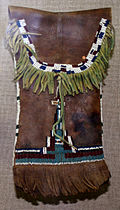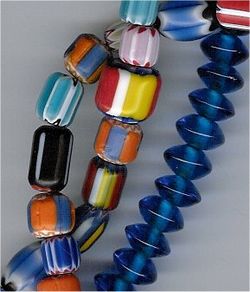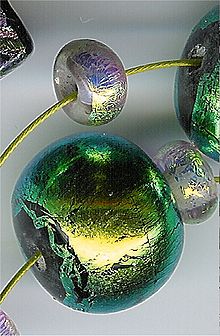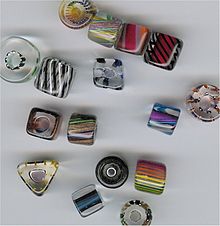- Bead
-
For other uses, see Bead (disambiguation).
A bead is a small, decorative object that is usually pierced for threading or stringing. Beads range in size from under 1 millimetre (0.039 in) to over 1 centimetre (0.39 in) in diameter. A pair of beads made from Nassarius sea snail shells, approximately 100,000 years old, are thought to be the earliest known examples of jewellery. [1][2] Beadwork is the art or craft of making things with beads. Beads can be woven together with specialized thread, strung onto thread or soft, flexible wire, or adhered to a surface (e.g. fabric, clay).
Contents
Types of beads
Beads may be divided into several types of overlapping categories, based on different criteria such as component materials, manufacturing process, place or period of origin, surface patterning, or general shape. In some cases, such as millefiori and cloisonné beads, multiple categories may overlap in an inseparably interdependent fashion.
Components
Beads can be made of many types of materials. The earliest beads were made of convenient natural materials; when found, these could be readily drilled and shaped. As human technology became capable of obtaining or working with more difficult natural materials, those were added to the range of available substances. The same was true of new synthetic materials when created.
In modern manufacturing, the most common bead materials are wood, plastic, glass, metal, and stone.
Natural materials
Beads are still made from many naturally-occurring materials, both organic (i.e., of animal- or plant-based origin) and inorganic (purely mineral origin). However, some of these materials now routinely undergo some extra human processing beyond mere shaping and drilling, such as color enhancement via dyes or irradiation. Beads can also be made from chocolate. These types of beads are edible, and commonly found in Indonesia and central Mexico.[citation needed]
The natural organics include bone, coral, horn, ivory, seeds (such as tagua nuts), animal shell, and wood. For most of human history, pearls were the ultimate precious beads of natural origin because of their rarity, although the pearl-culturing process has now made them far more common. Amber and jet are also of natural organic origin, although both materials have undergone partial geologic fossilization.
The natural inorganics include various types of stones (from gemstones to common minerals) and metals. Of the latter, only a few precious metals occur in pure forms, but other purified base metals may as well be placed in this category along with certain naturally-occurring alloys such as electrum.
Synthetic materials
The oldest-surviving synthetic materials used for beadmaking have generally been ceramics: pottery and glass. Beads were also made from the ancient alloys such as bronze and brass, but as those were more vulnerable to oxidation, those have generally been less well-preserved at archaeological sites.
Many different subtypes of glass are now used for beadmaking, some of which have their own component-specific names. Lead crystal beads have a high percentage of lead oxide in the glass formula, increasing the refractive index. Most of the other named glass types have their formulations and patterns inseparable from the manufacturing process.
Plastic fusible beads are also known as Perler Beads, or called "melty beads" by young children. These small colorful beads can be placed on a solid plastic-backed peg array to form designs and then melted together with a clothes iron; alternatively, they can be strung into necklaces or bracelets, or woven into keychains. Fusible beads come in many colors and degrees of transparency/opacity, including varieties that glow in the dark or have internal glitter; peg boards come in various shapes and several geometric patterns.
Manufacturing
Modern mass-produced beads are generally shaped by carving or casting, depending on the material and desired effect. In some cases, more specialized metalworking or glassworking techniques may be employed, or a combination of multiple techniques and materials such as cloisonné.
Glassworking
Most glass beads are pressed glass, mass-produced by preparing a molten batch of glass of the desired color and pouring it into molds to form the desired shape. This is also true of most plastic beads.
A smaller and more expensive subset of glass and lead crystal beads are cut into precise faceted shapes on an individual basis. This was once done by hand, but has largely been taken over by precision machinery.
"Fire-polished" faceted beads are a less expensive alternative to hand-cut faceted glass or crystal. They derive their name from the second half of a two-part process: first, the glass batch is poured into round bead molds, then they are faceted with a grinding wheel. The faceted beads are then poured onto a tray and briefly reheated just long enough to melt the surface, "polishing" out any minor surface irregularities from the grinding wheel.
Specialized glass techniques/types
There are several specialized glassworking techniques that create a distinctive appearance throughout the body of the resulting beads, which are then primarily referred to by the glass type.
If the glass batch is used to create a large massive block instead of pre-shaping it as it cools, the result may then be carved into smaller items in the same manner as stone. Conversely, glass artisans may make beads by lampworking the glass on an individual basis; once formed, the beads undergo little or no further shaping after the layers have been properly annealed.
Most of these glass subtypes are some form of fused glass, although goldstone is created by controlling the reductive atmosphere and cooling conditions of the glass batch rather than by fusing separate components together.
Dichroic glass beads incorporate a semitransparent microlayer of metal between two or more layers. Fibre optic glass beads have an eyecatching chatoyant effect across the grain.
There are also several ways to fuse many small glass canes together into a multicolored pattern, resulting in millefiori beads or chevron beads (sometimes called "trade beads"). "Furnace glass" beads encase a multicolored core in a transparent exterior layer which is then annealed in a furnace.
More economically, millefiori beads can also be made by limiting the patterning process to long, narrow canes or rods known as murrine. Thin cross-sections, or "decals", can then be cut from the murrine and fused into the surface of a plain glass bead.
Shapes
- Bugle beads
Hair pipe beads
Elk rib bones were the original material for the long, tubular hair pipe beads.[3] Today these beads are commonly made of bison and water buffalo bones and are that popular for breastplates and chokers among Plains Indians. Black variations of these beads are made from the animals' horns.
Seed beads
Main article: Seed beadSeed beads are uniformly shaped spheroidal or tube shaped beads ranging in size from under a millimetre to several millimetres. "Seed bead" is a generic term for any small bead. Usually rounded in shape, seed beads are most commonly used for loom and off-loom bead weaving.
Place or period of origin
African trade beads or slave beads may be antique beads that were manufactured in Europe and used for trade during the colonial period, such as chevron beads; or they may have been made in West Africa by and for Africans, such as Mauritanian Kiffa beads, Ghanaian and Nigerian powder glass beads, or African-made brass beads.
Austrian crystal is a generic term for cut lead-crystal beads, based on the location and prestige of the Swarovski firm.
Czech glass beads are made in the Czech Republic, centralized around an area called Jablonec nad Nisou. Production of glass beads in the area dates back to the 14th century, though production was depressed under communist rule. Because of this long tradition, their workmanship and quality has an excellent reputation.
Vintage beads, in the collectibles and antique market, refers to items that are at least 25 or more years old. Vintage beads are available in materials that include lucite, plastic, crystal, metal and glass.
Miscellaneous ethnic beads
Tibetan Dzi beads and Rudraksha beads are customary for making Buddhist and Hindu rosaries (malas). Magatama are traditional Japanese beads, and cinnabar was often used for beads in China. Wampum are cylindrical white or purple beads made from quahog or North Atlantic channeled whelk shells by northeastern Native American tribes, such as the Wampanoag and Shinnecock.[4] Job's tears are a popular seed bead among Southeastern Native American tribes.
Symbolic meaning of beads
In many parts of the world, beads are used for symbolic purposes, for example:
- use for prayer - e.g. rosary beads
- use for anti-tension devices, e.g. worry beads
- use as currency e.g. Aggrey beads from Ghana
- use for gaming e.g. owari beads for mankala
- greek kolomboi beads as in Crete
Surface patterns
After shaping, glass and crystal beads can have their surface appearance enhanced by etching a translucent frosted layer, applying an additional color layer, or both. Aurora Borealis, or AB, is a surface coating that diffuses light into a rainbow. Other surface coatings are vitrail, moonlight, dorado, satin, star shine, heliotrope.
Faux beads are beads that are made to look like a more expensive original material, especially in the case of fake pearls and simulated rocks, minerals and gemstones. Precious metals and ivory are also imitated.
Tagua nuts from South America are used as an ivory substitute since the natural ivory trade has been restricted worldwide.
See also
- Glass beadmaking
- Ultraviolet-sensitive bead
- Venetian beads
References
Further reading
- Beck, Horace (1928) "Classification and Nomenclature of Beads and Pendants." Archaeologia 77. (Reprinted by Shumway Publishers York, PA 1981)
- Dubin, Lois Sherr. North American Indian Jewelry and Adornment: From Prehistory to the Present. New York: Harry N. Abrams, 1999: 170-171. ISBN 0-8109-3689-5.
Beadwork Beads Aggry beads · Bead · Chevron bead · Glass beadmaking · Faturan · Hair pipe · Heishe · Kiffa beads · Love beads · Millefiori · Murano beads · Peranakan cut beads · Powder glass beads · Seed bead · Sequin · Trade beads · Wampum
Tools and techniques Bead crochet · Bead embroidery · Bead stringing · Bead weaving · Brick stitch · Peyote stitch · Square stitchBead artists Richard Aitson · Marcus Amerman · Martha Berry · Chipeta · Juanita Growing Thunder Fogarty · Teri Greeves · Maude KeggRelated Categories:- Beadwork
- Craft materials
- Jewellery components
Wikimedia Foundation. 2010.








